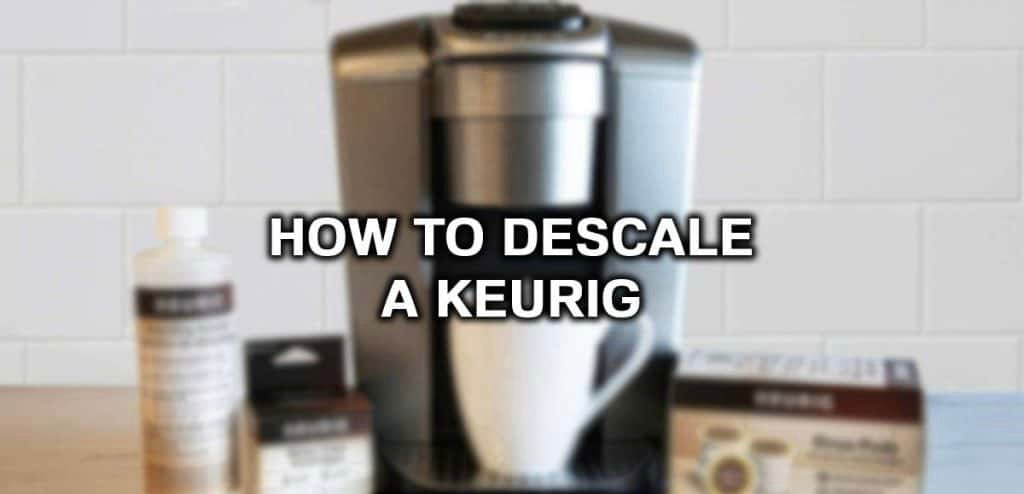Most coffee machines need to be cleaned out once per month, either using a descaling solution or vinegar. Typically, this involves running the machine once with the cleaning solution and at least twice more to flush it.
Descaling isn’t the most fun part of the coffee-making process, but it’s absolutely necessary for a well-working (and clean!) machine. Descaling is particularly important in single-serve machines, which, yes, includesWe’ll go through it step by step in just a second, but just to drive home how important this is...
How Dirty is my Coffee Maker?
For all of you out there who don’t seem to think your coffee maker needs to be cleaned, hold that thought until you know the names of the germs, mold, and bacteria housed in your machine.
Without thinking too deeply into it, it makes sense that you wouldn’t need to clean the coffee maker a ton. Super hot water should boil away anything, right? Not to mention, caffeine is naturally antimicrobial. Unfortunately, it doesn’t quite work that way.
Our minds always immediately turn to our basic understandings of buying any sort of technology item—the warranty always expires right before it breaks, manufacturers always err on the side of caution so they can shirk responsibility should issues arise, and, of course, they want to get you to buy more of their special cleaner. Usually, we’d agree, but this is not that.
What do the professionals say?
We were nonbelievers, too, until one of our team members found mold growing in the water reservoir of their household Keurig and was unable to stomach using it for upwards of six months.
It’s not just special to some of us. A local news station went around Chicago and randomly asked to swab machines in 10 homes, which were then inspected by microbiologist Roman Golash at Loyola University. He found gram-positive strains of bacteria including staphylococcus, streptococcus, and bacillus cereus, along with e-coli.
Additionally, a study done in 2011 by the NSF International, a non-profit independent public health organization, showed very similar results, including that coffee machines had more germs than most other areas of the kitchen and bathroom.
Alright—do we have your attention now? Good. Let’s have a serious discussion about water, descaling, and what all of that actually means.
How Do Coffee Machines Get Germs?
Hot and moist crevices are bacteria’s absolute favorite place to grow and the entire internal workings of your coffee machine is a hot, moist crevice that gets clogged by calcium and magnesium in water.
The calcium and magnesium form in layers called limescale—yes, the same chalky, off-white substance you can find on things like your showerhead or other places where metal and hot hard water meet.
If your first reaction was to use distilled water, which only has minute traces of these minerals, you wouldn’t necessarily be wrong, but it’s not quite the right solution, either. While it may prevent the buildup of limescale, it won’t give the result you want.
In a true twist of irony, the same minerals that are so detrimentally fatal to your coffee machine are the same ones that help bring out the most delicious of flavors in your mug of joe. Without calcium and magnesium taking up molecular space in your water, there’s simply too much room—the coffee over-extracts and results in that terrible bitter taste we all despise.

How to Descale a Keurig Coffee Maker
Slowly over time...
There will be visible and audible indications that it’s time to descale. You likely won’t even notice them until they’re a supreme annoyance on your morning schedule. The first symptom will undoubtedly be a slow down in the roasting process—it’ll be especially noticeable in single-serve machines.
Eventually, it won’t brew the same amount of coffee. So, now, it’s taking longer and not provided you with enough of the caffeinated goodness you want. You’ll likely hear some hefty chugging sounds, too, as water struggles to get through the clogged pathways. Once you’ve noticed these symptoms, it’s likely far past time to descale your machine.
Eventually...
You’ll notice a difference in taste, a very unpleasant morning surprise. Some describe the taste as chalky or even a disgustingly sweet, acidic taste. But however your taste receptors register the anomaly, there’s nothing enjoyable about it. Once you’ve reached this state for long enough, there’s a low chance that you’ll be able to descale it with much success.
To avoid needing to throw out your coffee maker, a machine used daily should be descaled on a very regular schedule, between 1 to 3 months depending on manufacturer recommendation and usage. On top of totally bypassing the issues of an underperforming machine, this will also prolong the life of your coffee maker.
Luckily, there’s nothing complicated about descaling your machine, as complicated as the word “descaling” sounds.
What is Descaling?
To “descale” something means to remove the hard deposits formed by chemicals in water from something, typically a showerhead, pipes, kettle, or coffee maker. While it is a chemistry term, you don’t need a chemist to descale your machine.
Descaling is deceptively simple and takes less than fifteen minutes. Fifteen short minutes each month for a longer lifespan on your beloved coffee maker seems worth it to us! So, on to the real question: vinegar or descaling solution?
How to Descale a Keurig Coffee Maker
Slowly over time...
There will be visible and audible indications that it’s time to descale. You likely won’t even notice them until they’re a supreme annoyance on your morning schedule. The first symptom will undoubtedly be a slow down in the roasting process—it’ll be especially noticeable in single-serve machines.
Eventually, it won’t brew the same amount of coffee. So, now, it’s taking longer and not provided you with enough of the caffeinated goodness you want. You’ll likely hear some hefty chugging sounds, too, as water struggles to get through the clogged pathways. Once you’ve noticed these symptoms, it’s likely far past time to descale your machine.
Eventually...
You’ll notice a difference in taste, a very unpleasant morning surprise. Some describe the taste as chalky or even a disgustingly sweet, acidic taste. But however your taste receptors register the anomaly, there’s nothing enjoyable about it. Once you’ve reached this state for long enough, there’s a low chance that you’ll be able to descale it with much success.
To avoid needing to throw out your coffee maker, a machine used daily should be descaled on a very regular schedule, between 1 to 3 months depending on manufacturer recommendation and usage. On top of totally bypassing the issues of an underperforming machine, this will also prolong the life of your coffee maker.
Luckily, there’s nothing complicated about descaling your machine, as complicated as the word “descaling” sounds.
What is Descaling?
To “descale” something means to remove the hard deposits formed by chemicals in water from something, typically a showerhead, pipes, kettle, or coffee maker. While it is a chemistry term, you don’t need a chemist to descale your machine.
Descaling is deceptively simple and takes less than fifteen minutes. Fifteen short minutes each month for a longer lifespan on your beloved coffee maker seems worth it to us! So, on to the real question: vinegar or descaling solution?
Vinegar vs. Descaling Solution
Everyone wants a definitive answer, the best way to properly descale and deep clean your machine is using a descaling solution. Some people say that the white vinegar leaves a lingering taste, but many also tout it as the ideal method to clear away limescale. Some manufacturers, like Keurig, solely recommend a descaling solution to clean their machines.
Whether you’re looking for how to descale a traditional coffee pot, how to descale a Keurig, or even how to descale a Keurig 2.0, you can clean any machine with our descaling solution.



